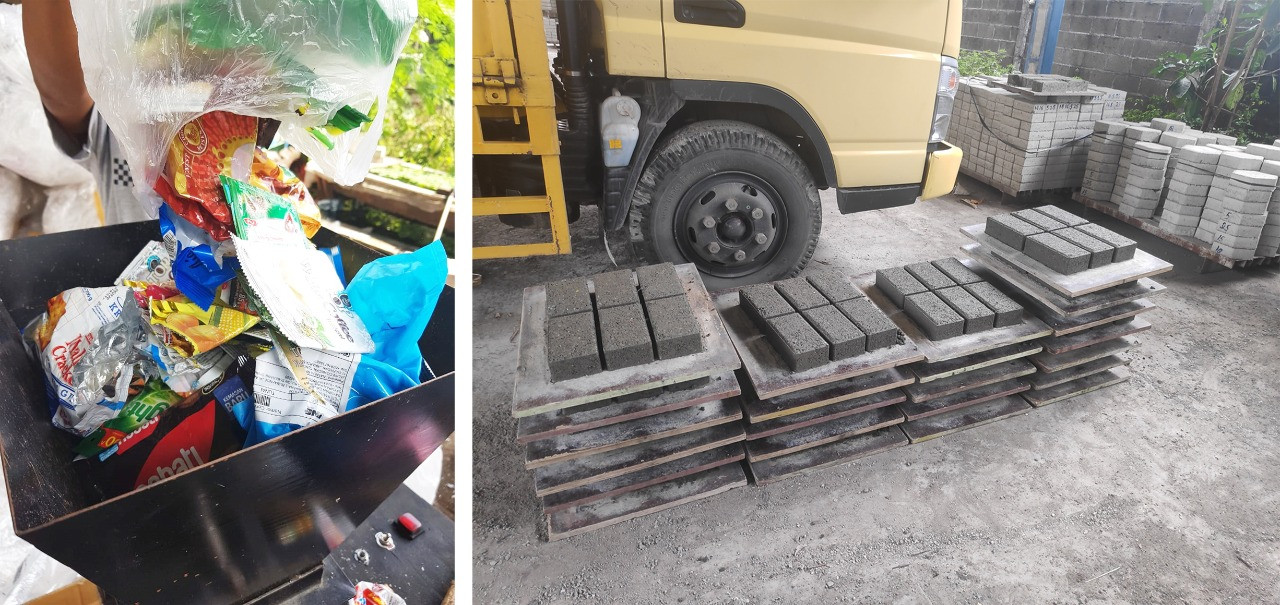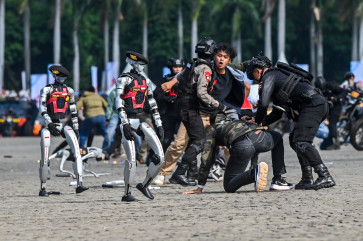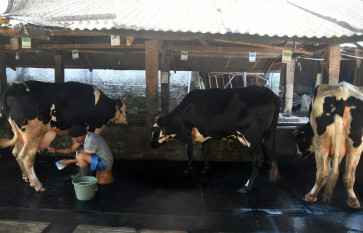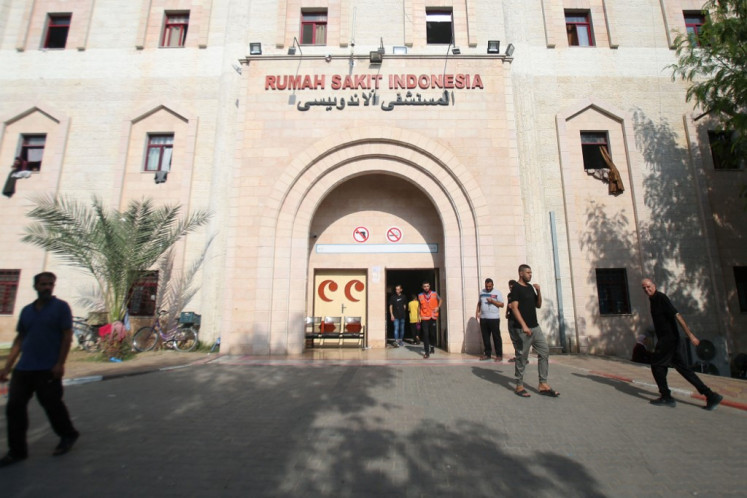Popular Reads
Top Results
Can't find what you're looking for?
View all search resultsPopular Reads
Top Results
Can't find what you're looking for?
View all search resultsInnovative way to treat plastic sachet waste
Commonly, plastic sachet waste is burned, thrown into a landfill or ends up littering the environment or the ocean. Is there any other way of treating discarded plastic sachets so they do not damage the environment?
Change text size
Gift Premium Articles
to Anyone
M
any of us are well familiar with plastic sachet waste. We eat instant noodles, drink coffee sachets, clean our hair with shampoo and buy snacks in plastic packaging. We may ask where the plastic waste ends up.
Commonly, plastic sachet waste is burned, thrown into a landfill or ends up littering the environment or the ocean. Is there any other way of treating discarded plastic sachets so they do not damage the environment?
Obsessed by this question, Novita Tan and Ovy Sabrina, whose father is in in the building materials business, conducted a literature study and consulted with a civil engineer lecturer in 2018.
After a trial-and-error process, they finally found a formula for turning used plastic sachets into material mix for producing paving bricks.
The mass product, branded as Rebricks, was officially launched in November 2019, several months before confirmed cases of coronavirus were found in Indonesia.
The plastic sachet waste that we find in our daily life -- packaging for food, coffee, coffee creamer, biscuits, laundry detergent, cosmetics, seasoning and the like -- are made of laminated plastic and aluminum film, making it hard to recycle because a chemical process is needed to separate the plastic and aluminum.
“People in the plastic industry consider it as waste from waste. Commonly, Bank Sampah (waste bank) rejects the sachet waste and scavengers leave them behind because they have no economic value,” says the co-founder of Rebricks.
On the contrary, other kinds of plastic waste, such as bottles, which are commonly used to hold potable water and other drinks, have economic value. The bottles are made from polyethylene terephthalate (PET), which are more easily recyclable. “It is no wonder that waste banks accept the plastic bottle waste and many scavengers have a keen interest in collecting them, because they can make money from the waste,” she says.
But reducing the amount of used plastic sachets does matter because if left unmanaged, the waste and other kinds of plastic will potentially bring about environmental problems, such as flooding and marine pollution, she says.
Trash management
Touching upon trash management, we learn that the volume of recycled plastic waste at final disposal sites (TPA) across Indonesia remains small compared to the volume of waste piling up at the sites. Of the 65 million tons of trash produced every day, only 7 percent is recycled and 69 percent ends up in landfills, according to CNN Indonesia in 2018.
Several dumpsites accommodate waste exceeding their capacity, which poses a threat to the operation of the sites. The 110.3-hectare Bantar Gebang landfill in Bekasi, West Java is a case in point. The volume of garbage at the dumpsite has reached 39 million tons with a height of 40 meters.
Jakarta Environment Agency head Isnawa Adji said in 2018 that with the dumpsite receiving up to 7,000 tons of garbage a day, the final site was expected to last only another three years.
As part of its endeavors to solve the garbage problem, the government has launched the “Indonesia Bersih Sampah 2025” (Clean from Waste) program. The initiative is expected to reduce 30 percent of garbage from its original source and manage and treat at least 70 percent of waste so it does not pile up at one disposal site.
Novita understands the garbage problem facing Indonesia. But she says the reasons behind taking advantage of the used plastic sachets to produce paving bricks has no direct connection with the government’s intention to achieve its clean-from-waste target, “but we passionately support the government’s waste-free drive.”
She explains that 1 square meter of paving bricks produced by Rebricks contains up to 880 sachets, or about 20 percent of the materials commonly used in making conventional paving bricks. Apart from the crushed sachets, the paving bricks by Rebricks use other materials including cement and gravel.
Currently, the factory has the capacity to produce 100 sq m of paving blocks per day and recycle 880,000 plastic sachets. “The more paving bricks we produce, the more plastic sachet waste we treat,” she says.
Waste donors
To get the plastic sachets for their eco-friendly paving bricks, Ovy and Novita initially collected them themselves by visiting several food stalls and coffee shops where they received the used sachets, but “after we announced that we were creating mass eco-friendly products from plastic sachet waste on social media, we got plenty of plastic waste from many people. Surprisingly, we not only received used sachets from Jakarta, but also from outside the capital, such as several cities in Yogyakarta, East Java, Kalimantan, Bali and Sulawesi,” she says.
Individuals or families send their sachet waste to Rebricks’ drop points in Jakarta. “The used sachets to be sent to us should be dry. That’s the only requirement,” she says.
The COVID-19 is a blessing in disguise for Rebricks, as during the pandemic they received an increased volume of used plastic sachets from the public. “Previously we received an average of 20 kilograms of used sachets per week. But thanks to WhatsApp, which we use to send the message, we now receive an average of 100 kg of used sachets per week,” she says.
Several restaurants, food and beverage stalls, the Family Welfare Movements (PKK) and producers of snacks in packaging are listed as waste donors that provide used plastic sachets for Rebricks on a regular basis.
However, families have also sent sachet waste, which has made Novita and Ovy highly passionate about what they are doing. “Once we received a clean envelope inside of which there were five sheets of sachets, with a note reading ‘Thank you for treating sachet waste’.”
Aside from reducing the number of discarded plastic sachets, the products themselves are claimed to be environmentally friendly because the paving bricks allow water to drain through, thus avoiding water inundation.
Despite the environmental advantages, when it comes to paving brick options, many people are still less enthusiastic than they are about sending the sachet waste, she says.
So far the demand for Rebricks’ paving bricks mostly comes from individual families that make small-scale purchases, according to Novita.
After being closed for more than three months due to the COVID-19 pandemic, Rebricks reopened its workshop following the Jakarta administration’s decision to relax the large-scale social restrictions (PSBB).
She expressed the hope that more people, including government officials and property developers, will take environmental aspects into account in developing construction projects and this way, “we’ll participate in any large-scale construction projects by supplying the eco-friendly paving bricks.”
By turning used plastic sachets into paving bricks, Rebricks has introduced another way of treating plastic waste, which is good for the environment.










